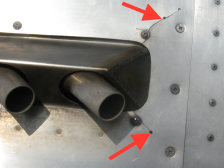|
Aircraft fatigue is the result of stress, and it can seriously erode the longevity of your airframe. There are no good outcomes to leaving fatigue unaddressed. “Fatigue damage and its consequences are the most serious structural design and maintenance issues that have to be addressed.”* From an engineering perspective, fatigue is caused by vibration and the number of vibration cycles. The greater the magnitude of the vibration, the more stress it produces. When a propeller that isn’t in balance is producing the vibration, you can’t eliminate the cycles, or prop rotations, but you can reduce – even eliminate – the vibration associated with each one. An out-of-balance propeller produces a vibration with each rotation. This stress often manifests itself as airframe fatigue cracks, as pictured in the photo above. There is good news: stress that is the result of propeller imbalance is easy to address. Dynamically balancing your propeller can eliminate almost all of this vibration, and it’s important that you do so, as there’s a direct relationship between stress and the number of prop rotations. Unresolved, each prop rotation produces stress that steadily produces fatigue cracks and then propagates their growth. Pilots and owners don’t have to live with prop vibration that stresses the airframe. If you have fatigue cracks you’ll still need to stop-drill them, but dynamically balancing your prop will reduce or eliminate this source of stress, arresting fatigue crack propagation and preventing new ones from forming. Using the DynaVibe Classic, a dynamic prop balancer, it’s easy to reduce or eliminate this damaging vibration (the DynaVibe GX2 allows you to identify all sources of vibration, not just prop imbalance-induced). It’s a great investment in extending the life of your aircraft, and a balanced prop produces a smoother safer ride! If you have fatigue cracks on your airplane and you’d like to know about propeller balancing and vibration resolution, contact us for a consultation at [email protected] or by calling: 405.896.0026. *Finda, et. al., "Prediction of Fatigue Crack Growth in Airframe Structures", 1985.
|


 RSS Feed
RSS Feed


